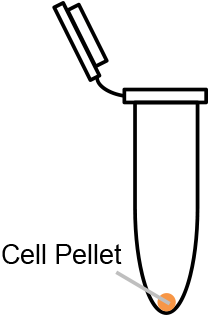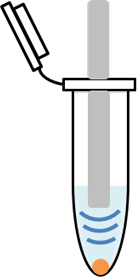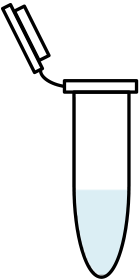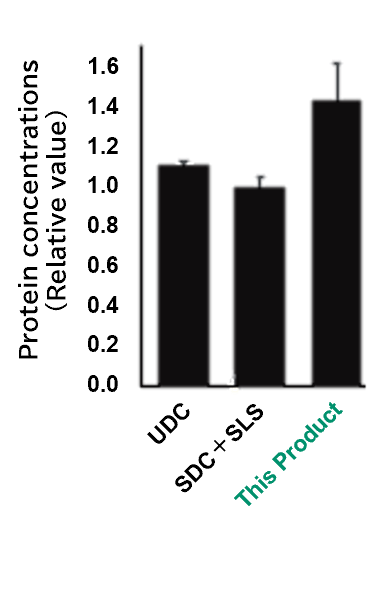LysoPure (TM) Protein Extraction-PTS Solution
- for Genetic Research
- Manufacturer :
- FUJIFILM Wako Pure Chemical Corporation
- Storage Condition :
- Keep at 2-10 degrees C.
- Structural Formula
- Label
- Packing
|
Comparison
|
Product Number
|
Package Size
|
Price
|
Inventory
|
|
|---|---|---|---|---|---|
|
|
|
5mL
|
|
In stock in Japan |
Document
Product Overview
LysoPure™ Protein Extraction-PTS Solution is a solubilizing agent designed for protein extraction, an essential pretreatment step in proteomics.
Developed based on the PTS method, this product effectively solubilizes difficult-to-extract proteins while preserving proteolytic enzyme activity and enables easy removal of the agent via liquid-liquid partitioning. This product is an improved version of previously reported PTS solutions1-2) , offering improved protein solubilization and greater proteolytic enzyme activity than conventional PTS solutions. Additionally, it reduces cleavage errors by proteolytic enzymes. This product can also be used in proteomic studies of extracellular vesicles, including exosomes.
Features
- Enables the extraction of highly hydrophobic proteins, including membrane proteins
- Does not inhibit proteolytic enzyme activity
- The solubilizing agent can be easily removed via liquid-liquid partitioning
Protocol
Protein Extraction from cells

Sample
Preparation Harvest cells,
centrifuge, and
discard the supernatant
Protein
Extraction Add PTS solution
and suspend the cells
Ultrasonic TreatmentReduce the viscosity of suspended the cells

Reduction and
Alkylation Add DTT and IAA
Protein Digestion Dilute with TEAB
or AmBic,
then add Lys-C/trypsin
Addition of
Hydrophobic
Solvent Add ethyl acetate
to the solution
Acidification Acidify with TFA

Surfactant
Removal Remove the
upper phase
Desalting
- LC-MS/MS
Protein Extraction from Extracellular Vesicles (EVs) (when using MagCapture™ Exosome Isolation Kit PS Ver.2)
-
Sample PreparationUse a magnetic stand to pellet EV-bound magnetic beads, then discard the supernatant
-
Protein ExtractionAdd PTS solution and suspend the beads
-
Reduction and
AlkylationAdd DTT and IAA -
Protein DigestionDilute with TEAB or AmBic, then add
Lys-C/trypsin -
Addition of Hydrophobic SolventAdd ethyl acetate
to the solution -
AcidificationAcidify with TFA
-
Surfactant RemovalRemove the upper phase
-
Desalting
- LC-MS/MS
Data
Data
Protein Solubilization

Proteins were extracted from human liver microsomal fractions using various PTS solutions with different surfactant compositions. The resulting protein concentrations were compared across the different solutions.
[Result]
This product demonstrated superior solubilization compared to conventional PTS solutions containing other surfactants.
Proteolytic Enzyme Activity and Cleavage Error Rate
| PTS Solution | Trypsin | Lysyl Endopeptidase (Lys-C) | ||||
|---|---|---|---|---|---|---|
| Concentration of PTS solution |
Activity | Initial velocity | Concentration of PTS solution |
Activity | Initial velocity | |
| SDC+SLS | 4 mM | 12.6 | 4.4 | 4 mM | 2.5 | 1.9 |
| SDC+SC | 8 mM | 5.7 | 2.3 | 8 mM | 2.6 | 2.4 |
| SDC+CDC | 8 mM | 7.5 | 4.4 | 8 mM | 2.4 | 1.8 |
| This Product | 8 mM | 10.3 | 4.6 | 8 mM | 2.6 | 1.8 |
| PTS Solution | Number of Cleavage Error |
|---|---|
| UDC | 586 |
| SDC+SLS | 723 |
| SLS+SC | 273 |
| This Product | 291 |
- CDC
- Kenodeoxycholic acid
- SC
- Sodium cholate
- SDC
- Sodium deoxycholate
- SLS
- Sodium lauroyl sarcosinate
- UDC
- Ursodeoxycholic acid
[Result]
SDC+SLS exhibited the highest trypsin activity but also resulted in the highest number of cleavage errors.
In contrast, although this product had lower trypsin activity than SDC+SLS, it exhibited the highest lysyl endopeptidase activity with fewer cleavage errors. These findings show that this product offers well-balanced performance, combining high enzymatic activity while reducing the number of cleavage errors, making it an ideal PTS solution.
References
- 1)Masuda, T., Tomita, M. & Ishihama, Y.: J. Proteome Res., 7(2), 731(2008).
Phase transfer surfactant-aided trypsin digestion for membrane proteome analysis - 2) Masuda, T. et al.: Mol. Cell. Proteomics, 8(12), 2770(2009).
Unbiased Quantitation of Escherichia coli Membrane Proteome Using Phase Transfer Surfactants
FAQ
About product usage
- How many times can we use this product? (Package Size:5 mL)
- The amount used will vary depending on the sample.
The following are guidelines for the amount used per extraction.
Cell protein extraction: 1 mL per extraction (5 extractions)
Extraction of extracellular vesicle proteins: 100 μL per extraction (50 extractions)
Overview / Applications
Property
| Density | 0.999 - 1.005g/mL |
|---|
Manufacturer Information
Alias
For research use or further manufacturing use only. Not for use in diagnostic procedures.
Product content may differ from the actual image due to minor specification changes etc.
If the revision of product standards and packaging standards has been made, there is a case where the actual product specifications and images are different.











